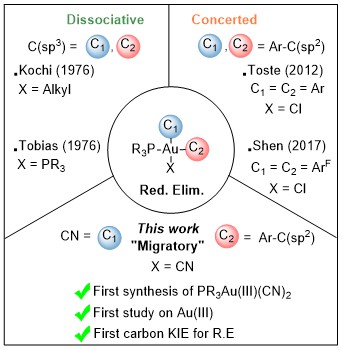Novel “migratory” C(sp2)-C(sp) reductive elimination on Gold(III) complexes: a mechanistic insight
In recent years, gold-catalyzed cross couplings have come to the forefront of synthetic methods for the formation of both C-C and C-X bonds.1 Reductive elimination at a gold(III) intermediate precedes the formation of the desired bond and is one of the key steps in these reactions. An in-depth understanding of the factors that affect the rate and selectivity of the elementary organometallic processes underlying the reaction mechanism is crucial to develop more efficient catalytic systems. Herein, we present a combine detailed experimental and computational study on the C(sp2)-C(sp) reductive elimination at monophosphine arylcyanogold(III) complexes. Our investigations unravel a “migratory” reductive elimination mechanism not observed previously in well-studied C(sp3)-C(sp3)2 and C(sp2)-C(sp2)3 reductive elimination processes at highly oxidized gold centers.4

[1] (a) G. Zhang, Y. Peng, L. Cui, Z. Zhang, Chem. Int. Ed. 2009, 48, 3112; (b) M. N. Hopkinson, A. Tessier, A. Salisbury, G. T. Giuffredi, L. E. Combettes, A. D. Gee, V. Gouverneur, Chem. Eur. J. 2010, 16, 4739; (c) W. E. Brenzovich, Jr., J. F. Brazeau, F. D. Toste, Org. Lett. 2010, 12, 4728; (d) L. T. Ball, G. C. Lloyd-Jones, C. A. Russell, Science 2012, 337, 1644; (e) T. De Haro, C. Nevado, J. Am. Chem. Soc. 2010, 132, 1512.
[2] A. Tamaki, S. A. Magennis, J. K. Kochi, Am. Chem. Soc. 1974, 96, 6140; b) T. A. Albright, R. Hoffmann, J. K. Kochi, J. Am. Chem. Soc. 1976, 98, 7255; c) S. Komiya, J. K. Kochi, J. Am. Chem. Soc. 1976, 98, 7599; d) P. L. Kuch, R. S. Tobias, J. Organomet. Chem. 1976, 122, 429.
[3] J. Wolf, M. S. Winston, F. D. Toste, F. D. Nat. Chem. 2013, 6, 159.
[4] Genoux, J. González, E. Merino, C. Nevado, manuscript in preparation